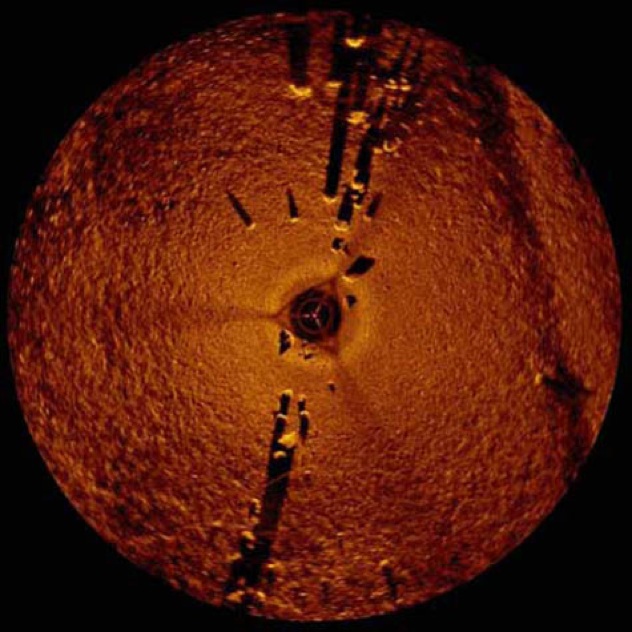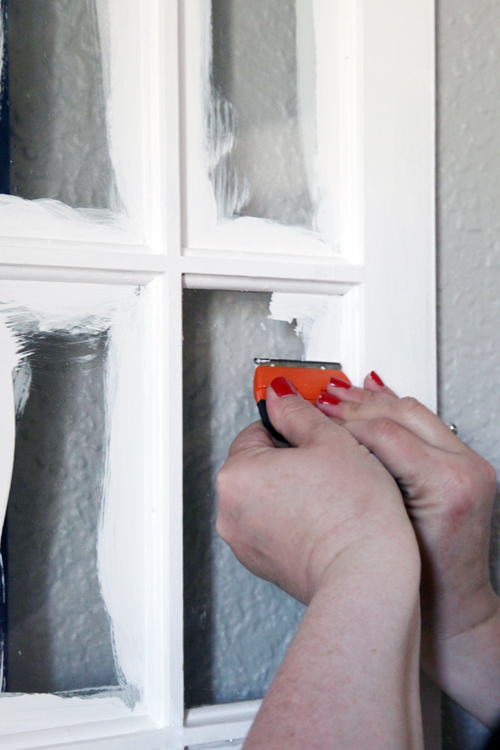Thaikylie
Shared posts
Quick Tip Tuesday: A Painting "Pane"
The thing with these types of projects, whether old doors, windows or cabinets, is that they can be a literal pane in the glass. Using painters tape is not fool-proof. Paint still tends to seep and can tear away all of your hard work when being peeled away. Not to mention, the hours upon hours it would take to tape each pane both front and back.
So she just painted. And painted some more... both inside and out. In fact, she started with primer, then followed up with a couple of coats of paint.
And just like many of us, she is busy and let it sit for a few weeks before finishing up her project. But that was still OK. When it came time to finally fix those panes, it was easy as pie.
She started by laying down some plastic on the floor below the built-ins to catch the falling paint. That's right, the paint is about to fall off those glass panes!
Next, she mixed vinegar and water into a spray bottle (heavy on the vinegar) and generously sprayed down the glass.
Using a small blade from the local hardware store (similar), she scored along the edge of the pane and then just scraped the paint right off.
It really seemed to just fall off, even after sitting for weeks and curing. I was really impressed at the lack of effort needed. Definitely easier than taping everything off and then messing with that aftermath.
Just put on your favorite Netflix show or some Pandora music and moments later you will have paint-free panes.
This may be the oldest painting trick in the books, but I felt it was my duty to share my excitement with y'all. This just changed my painting future!
Looking for more quick tips? Check out the entire series here!
10 Mysterious Underwater Anomalies
From surviving ancient manuscripts it is clear that there has always been a belief that new lands could rise up from the ocean, while old ones could sink into the sea, destroying former civilizations in the process. The most famous of all the lost lands is that of Atlantis, described in great detail by Plato almost 2,500 years ago. During the past century as we developed the technology to fly and with the advent of sonar and better diving equipment, numerous underwater anomalies have been discovered. Sites such as the Bimini Road have been probed and discussed at length by many, but not all of the sites are so close to the surface, and often times the depth of the water limits our investigations to sonar images and samples taken by submersibles.

In 2003, scientists were surprised to discover a massive circular stone structure underneath 30 feet (9 m) of water in the Sea of Galilee. The structure is comprised of basalt rocks, stacked in a cone shape and it is twice the size of Stonehenge in the UK. In their findings that were only recently published, archaeologists have noted that it shares some features of ancient communal burial sites found worldwide, but it may also be a ramp or a ceremonial structure. As they have never come across a structure of this size, with its specific features, they can only speculate as to its exact age, how it was constructed and how it was used.

The circular anomalies that can be seen off the coast of Florida, North Carolina, and Belize have been documented by enthusiasts and archaeologists alike. Even though they are found on a global scale, their true objective hasn’t been discovered so far – many believe they were used as an ancient type of burial mound. They are also very similar to stone structures that have been found in Saudi Arabia that can be seen on this website. It is believed that the underwater structures have been better preserved than those on dry land and may date back to ±8,000 BC. as those in Saudi Arabia have been dated to around 7,000 BC.

Divers discovered proof of Eastern Canada’s ancient past while taking part in a unique submarine project in 2005. They found the very curious stone structure at a depth of 40 feet (12 m) below the surface. It consists of a massive 1,000 lb (453 kg) elongated rock with an almost completely level surface resting on 7 baseball-sized stones, which in turn sits on a huge several thousand pound slab on top of a ledge. It was thought to be a natural formation until geologists and archaeologists looked at the images. The discovery of the man-made “rock cairn”, was deemed to be proven when an underwater archaeologist concluded the existence of three shims was enough proof that the structure was man-made.

Whether it is a UFO, a Nazi anti-submarine defense tool or simply a glacial rock that has been dragged across the sea floor, the discovery of the disc-shaped Baltic Sea anomaly (and its subsequent investigation in 2012) kept all the interested parties on the edge of their seats. Although Swedish explorers generally convinced everyone that it is a rock and not a UFO, their research has raised a lot of questions. Firstly, the rock didn’t have a silt-layer on it, which is usually the case when rocks have been lying still at the bottom of the ocean for any period of time. Furthermore, the 196 feet (60 m) wide rock seems to be covered by construction lines and boxes and it appears to be propped up by a 26 foot (8 m) high pillar.

Lake Baikal in southern Siberia is unique in many regards. It is the oldest, deepest and largest fresh water lake on earth. The sediment deposit on the bottom of the lake is more than 4 miles (7 km) deep and many of the fish species that thrive in its waters can be found nowhere else on earth. As its ice cover normally lasts into June, astronauts on the International Space Station were alarmed to see a very large circular area of thinned ice near the southern end of the lake in April 2009. To their astonishment, there was also another feature above a submarine ridge that divides the lake. Although the origin of the circles is a mystery, the distinct pattern would suggest that warmer water were brought to the surface, but hydrothermal activity has never been observed over the very deep water at the southern tip of the lake.

Even though Stonehenge in the UK is one of the most famous historical stone monuments in the world, it is not unique. Similar stone arrangements have been found worldwide. In 2007 while surveying the bottom of Lake Michigan with sonar, a team of underwater archaeologists discovered a series of stones aligned in a circle 40 feet (12 m) below the surface. One of the stones also seemed to feature a carving of a mastodon, an animal that has been extinct for 10, 000 years. If the site is validated, it would not be completely out of place, as other stone circles and petroglyph sites can be found in the vicinity.

A series of submerged structures discovered off the Cuban coast in 2001 captured the imaginations of archaeologists, researchers and Atlantis-hunters worldwide. Found by a company doing surveying work, the sonar images have shown symmetrical and geometric structures that covers an area of 200 ha (almost 2 square km) at depths between 2,000 and 2,460 feet (± 700 m). Skeptics believe the site is too deep to be manmade as it is estimated that it would have taken the structures 50,000 years to sink to their current depth. If conclusive proof can be found that these structures were indeed manmade, it would back up the Maya and local Yucatecos stories of an ancient island inhabited by their ancestors that vanished beneath the sea.

Since its discovery in 1987, the massive Yonaguni Monument off the coast of Japan has been a subject of debate between scientists, archaeologists and scholars. Many supporters claim that the site is natural but may have been modified by human hands like the rock-hewn terraces of Sacsayhuaman. If proven true, the site would have been modified during the last ice age – around 10,000 BC. Skeptics on the other hand believe the whole structure to be natural; that the drawings and carvings observed are nothing more than natural scratches. The fact remains that although Yonaguni’s features can be seen in many sandstone formations worldwide, the high concentration of questionable formations at one site is unlikely.

During expeditions in 2006 and 2007 the deeper waters to the west of Bimini were mapped using side-scan sonar and sub-bottom profiling. A number of rectangular features were discovered at a depth of 100 feet (30 m). They are all aligned in the same direction in straight, parallel lines. The researchers have claimed that the structures appear to be very much like those found off the coast of Cuba. At a later dive managed by the History Channel, the formations were better observed. There are about 50 stone piles, mainly 10 by 45 feet in size, and all at a depth that would place their age around 10,000 BC.

In May 2001, it was announced the ruins of an ancient city was discovered in the Gulf of Khambhat. The discovery was made with the help of sonar while routine pollution studies were being done. During the announcement, the site was described as evenly spaced dwellings, a drainage system, bath, granary and a citadel that pre-dates the Indus Valley Civilization. During follow-up investigations, the area was dredged and several artifacts were recovered. Among them were wood (dated ± 7,000 BC), stones described as hand tools, fossilized bones, pottery sherds and a tooth. Among the controversies are that all the supposed artifacts are stones of natural origin, that the “sherds” are natural geofacts and that the dredging could have allowed errant artifacts to be dug up along with the site’s, removing all credibility from the finds.
Hestie lives in Pretoria, South Africa. She is amazed by all the mysterious discoveries that dates back to 10,000 years ago
The post 10 Mysterious Underwater Anomalies appeared first on Listverse.
My lesson planning process
How I plan lessons:
1. Look at the next thing in the textbook and think “That’s shit. What were they thinking publishing that? And what the hell I am supposed to do with it?”
2. Get a cup of tea
3. Find something relevant of mine on my hard disk or online and have a moment of joy/ relief before I decide “That’s shit. What was I thinking producing that? Now what I am supposed to do?”
4. Get a cup of tea
5. Go to toilet to get rid of the previous tea
6. Suddenly think of something I can do and think “I’m a genius!”
7. Realise how much preparation that idea would entail and sink into depression
8. Stick the tea in the microwave
9. Get down to doing that prep, motivated by the illusion that it will result in students with that look of joy on their faces that TEFL school ads always show and sudden progress that will mean some of them might actually deserve to go up to the next level (despite 16 years of TEFL experience to suggest otherwise)
10. Get two thirds of the way through the prep before the motivation runs out, then complete the rest due to the sheer panic of having no other idea of what to do
11. See at least three silly typos on the way to class (caused by that lack of motivation and sheer panic at the end of the lesson planning process)
12. Correct at least three more typos during the class, whilst alternating between suicidal thoughts due to it not being a work of genius and joy that at least it hasn’t bombed and is something new
13. Add the corrected worksheet to the pile in the corner of my room
14. Look at the next page of the textbook
and repeat.
Not exactly highly recommended, but kind of works for me. And you?
How to use deliberate practice to improve your writing
Last week, as one of my last duties as research fellow at RMIT before I take up my new role at ANU, I hosted two seminars – one from Prof Anthony Pare from McGill and the other from Prof Helen Sword, the writer of the wonderful “Stylish Academic Writing”.
Helen and Anthony had many interesting observations about the process of learning to write, but both made the same basic point: very few of us have formal instruction in how to write like an academic.
As Anthony Pare pointed out, when you write essays as an undergraduate you are ‘eavesdropping’ on expert conversation; as a PhD student you are expected to be a part of that conversation. Writing for a teacher is easier than writing for your peers because the expectations are clearer. This is why many PhD students experience what he calls the “J curve”: a rapid drop in confidence, but a long term upswing as this new kind of writing practice is mastered.
Helen Sword explained that we pick up most of what we know about academic writing informally, from our supervisors and from reading; this learning process is adhoc, idiosyncratic and individualised. Informal learning has benefits, but generally speaking it’s harder to reach expert level unless you really push yourself. Helen noted that many people don’t even consult writing books or take advantage of the free advice on the web and therefore never reach an expert level.
One of the ways to push yourself to become a better writer is to engage in deliberate practice, a term I encountered in Cal Newport’s recent book “So good they can’t ignore you” (an excellent read by the way). Deliberate practice is a way of consistently stretching yourself out of your comfort zone and thereby increasing your skill.
I thought I’d expand on some of the concepts of deliberate practice via my own recent experience with exercise. Like many academics I’m not very body conscious, but I do try to be active because I know I’m built to survive famines and easily put on weight. In the past I have been into swimming and lifting weights at the gym; solo exercise sessions where I can be alone with my pain.
 The problem with solo exercise routines, as you probably know, is you are accountable to no one but yourself. Recognising we had a mutual problem in this area, my friend Joyce (@catspajamasnz) and I became exercise buddies.
The problem with solo exercise routines, as you probably know, is you are accountable to no one but yourself. Recognising we had a mutual problem in this area, my friend Joyce (@catspajamasnz) and I became exercise buddies.
The first thing Joyce suggested we try was a Zumba Fitness class. I’ll admit, I was not super enthusiastic. All I knew about Zumba was dance videos full of impossibly swelte people, wearing 80′s outfits and fluorescent shoes, swinging their dreadlocks around to Latin dance music. I told Joyce I didn’t like Latin dance music, mostly because of the accordions, but I went along with it.
Colour me surprised when I discovered that I LOVE Zumba. I don’t want you to get the impression I love Zumba because I am good at it, because I’m really not. I am so bad at it it’s laughable.
I laugh when I watch myself do awkward white girl dancing in the mirror and I laugh at the insanely silly accordian music. Laughing helps me stick with it because earning Zumba is not easy. According to the wikipedia entry, Zumba involves a mix of
“hip-hop, soca, samba, salsa, merengue, mambo, martial arts, and some Bollywood and belly dance moves”
In other words, it’s complicated. In case you’ve been under a rock for the last decade, this video gives you an idea of what it looks like:
The hardest part of Zumba, for me, is how unfamiliar the movements feel: I’ve danced before, but not like this. Writing like an academic used to unfamiliar too; both like and unlike any writing I had done before. Anthony Pare shared a quote from a PhD student who compared ‘academese’ to a foreign language. This is a nice description because part of the PhD process is learning to adopt a new kind of scholarly voice.
It takes time to be comfortable speaking ‘academese’ because it’s profoundly unnatural. The longer you persist at academic writing however, the more natural it will feel, so don’t wait until you are writing chapters or journal papers to start ‘speaking like an academic’. Practice this new academic voice as you take notes.
One way to do this is by paying close attention to the verbs. For example, if you were taking notes from this blog post, instead of writing:
“Learning Zumba is an example of deliberate practice in action”
You could write:
“Inger Mewburn argues that learning Zumba is an example of deliberate practice in action”
Including the verb ‘argues’ implies what Kamler and Thomson would call a ‘hands on hips’ stance. By pointing out that I am making an argument, as opposed to, for example, stating a fact, you are taking a position on what I am saying, rather than just copying it down.
If you were to take a deliberate practice approach, you would look to how you could extend this ‘positioning’ of yourself. For example, you could rewrite the note and include some of your own thoughts, like this:
“Inger (2012) claims that learning to do Zumba is an example of deliberate practice in action. While Zumba is difficult to master, and it may take time to get the basics down right, what Inger fails to realise is that learning Zumba is not at all like learning to write. For one thing, you need a computer, not fluorescent shoes.”
That’s pretty good – can you see what I just did? I just wrote a bit of a thesis in that note. I took a position on what Inger was saying about Zumba and I pointed out the tenuous, even ridiculous, connection between Zumba and writing.
In academic writing, how you say what you say is as important as what you say. Verbs are judgmental. By shifting the verb ‘argues’ (a neutral kind of verb) to the more aggressive ‘claims’ (a verb which implies I have not used enough evidence) I created what you might call a ‘meta text‘: signalling to the reader what I think about Inger’s statements about Zumba, without directly saying it.
The verbs I used in the above example lent my writing a negative critical stance. Deliberate practice involves repeating the same activity over and over, but striving to be better each time. So you could try adjusting your stance to see if you can improve on it. For example, I could try again, keeping my note critical, but using my verbs in a kinder way, starting with a positive verb like this:
“Inger (2012) explains how Zumba can be thought of as an example of deliberate practice in action. Her comparison between writing and Zumba is tenuous, but her main point is clear: both are complicated and take a long time to learn. In addition, fluorescent shoes look great – on writers as well as Zumba lovers.”
Shifting backwards and forwards between positive and negative stances in your notes is like working on Zumba step technique: it helps you to move your thinking around and make it more flexible.
Using your notes as a place to deliberately practice academic writing has two main benefits. It’s ‘low stakes’ writing; since you are the only audience for your notes, you can try out different points of view and play with ideas. Secondly, taking notes with verbs helps you to form ‘mini chunks’ of text that can be cut and pasted into your thesis, saving you time.
Look for tools to support your deliberate practice. For example, I keep a list of verbs on my wall so that I make sure to use a wide variety of them in my writing and thereby produce more sophisticated metatext. I make a point of regularly looking up the precise meaning of verbs I use, even familiar ones, in order to keep my writing precise.
Deliberate practice can increase enjoyment along with skill. After months of deliberate Zumba practice I was shocked to discover I had over 2 hours of Zumba music in my iTunes library… many with incredibly silly accordion riffs. Apparently I no longer hate Latin music or accordions! If you find writing painful now, you might find with a bit of deliberate practice you will start enjoying it in a whole new way.
Is there a skill you have learned through deliberate practice, such as playing an instrument? Are there times you have failed to keep up a skill or never really progressed to expert? Why? I’d love to hear your own insights on deliberate practice in the comments.
Related Posts
Developing your inner Yoda, er – scholar







